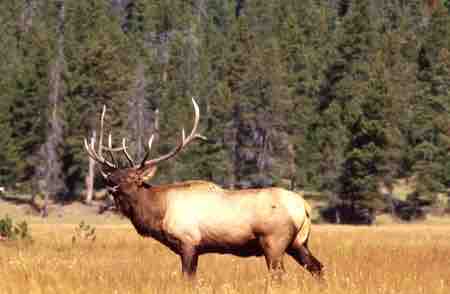Sexual Selection
The selection pressures on males and females to obtain matings is known as sexual selection. Sexual selection takes two major forms: intersexual selection (also known as 'mate choice' or 'female choice') in which males compete with each other to be chosen by females; and intrasexual selection (also known as 'male–male competition') in which members of the less limited sex (typically males) compete aggressively among themselves for access to the limiting sex. The limiting sex is the sex which has the higher parental investment, which therefore faces the most pressure to make a good mate decision.

Sexual selection in elk
This male elk has large antlers to compete with rival males for available females (intrasexual competition).Tn addition, the many points on his antlers represent health and longevity, and therefore he may be more desirable to females (intersexual selection).
Sexual Dimorphism
Males and females of certain species are often quite different from one another in ways beyond the reproductive organs. Males are often larger, for example, and display many elaborate colors and adornments, such as the peacock's tail, while females tend to be smaller and duller in decoration. These differences are called sexual dimorphisms and arise from the variation in male reproductive success.
Females almost always mate, while mating is not guaranteed for males. The bigger, stronger, or more decorated males usually obtain the vast majority of the total matings, while other males receive none. This can occur because the males are better at fighting off other males, or because females will choose to mate with the bigger or more decorated males. In either case, this variation in reproductive success generates a strong selection pressure among males to obtain those matings, resulting in the evolution of bigger body size and elaborate ornaments in order to increase their chances of mating. Females, on the other hand, tend to get a handful of selected matings; therefore, they are more likely to select more desirable males.

Sexual dimorphism
Morphological differences between males and females of the same species is known as sexual dimorphism.These differences can be observed in (a) peacocks and peahens, (b) Argiope appensa spiders (the female spider is the large one), and (c) wood ducks.
Sexual dimorphism varies widely among species; some species are even sex-role reversed. In such cases, females tend to have a greater variation in their reproductive success than males and are, correspondingly, selected for the bigger body size and elaborate traits usually characteristic of males.
The Handicap Principle
Sexual selection can be so strong that it selects for traits that are actually detrimental to the individual's survival, even though they maximize its reproductive success. For example, while the male peacock's tail is beautiful and the male with the largest, most colorful tail will more probably win the female, it is not a practical appendage. In addition to being more visible to predators, it makes the males slower in their attempted escapes. There is some evidence that this risk, in fact, is why females like the big tails in the first place. Because large tails carry risk, only the best males survive that risk and therefore the bigger the tail, the more fit the male. This idea is known as the handicap principle.

A male bird of paradise
This male bird of paradise carries an extremely long tail as the result of sexual selection.The tail is flamboyant and detrimental to the bird's own survival, but it increases his reproductive success.This may be an example of the handicap principle.
The Good Genes Hypothesis
The good genes hypothesis states that males develop these impressive ornaments to show off their efficient metabolism or their ability to fight disease. Females then choose males with the most impressive traits because it signals their genetic superiority, which they will then pass on to their offspring. Though it might be argued that females should not be so selective because it will likely reduce their number of offspring, if better males father more fit offspring, it may be beneficial. Fewer, healthier offspring may increase the chances of survival more than many, weaker offspring.